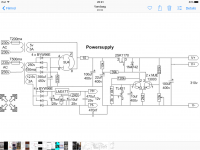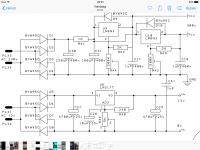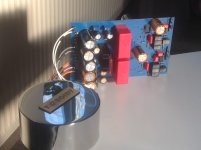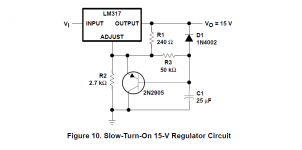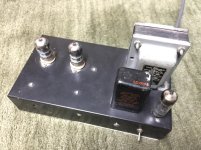Small signal tubes are going to be pulling a few milliamps constantly so supply regulation is of little concern. Regulation for minimizing noise? Sure. Current should be constant with this type of load.
This makes some sense. Ripple suppression is "the name of the game". A Π section filter containing a large inductance and big 2nd cap. will do that. Triad Magnetics C-1X is a 20 mA./15 H. part that's modest in cost.
The 6CA4 datasheet shows 47 μF. as acceptable in the 1st position, but I like to leave some leeway, especially with current production specimens. So, 33 μF. in the 1st position into a C-1X and 220 μF. in the 2nd position might work out quite nicely.
Below another two quiet power supplys.
First i use with the phonodude. Second i use with my hybrid phono preamp.
For 110v net just use transformer with the right primary voltage.
First i use with the phonodude. Second i use with my hybrid phono preamp.
For 110v net just use transformer with the right primary voltage.
Attachments
Last edited:
I've got a book on my night stand (it's actually next up) on valve amplifier design. Hopefully I can get some more power supply vocabulary under my belt and more of this will make sense. Or, if it's truly as simple as has been said, maybe I'll just be able to draw something up. It's become clear it's not going to be as simple as finding a schematic for something that meets my criteria, rounding up parts, and assembling something suitably functional. Fingers crossed.
People are making this way more complicated than necessary.
I built this over 10 years ago and its whisper quiet with the mosfet regulator. Its on a small hammond chassis with a 6X4 rectifier.
RJM Audio - Tube passive phono preamplifier
I built this over 10 years ago and its whisper quiet with the mosfet regulator. Its on a small hammond chassis with a 6X4 rectifier.
RJM Audio - Tube passive phono preamplifier
Yes, that RJM circuit is basically the same as what's been discussed so far, just using 6DJ8 tubes instead of 12AX7 and 12AT7. That would work just fine, although lower gain (probably about 35dB, correct?).
What's interesting is the all-passive power supply in that article. Even the 6V DC heater supply is done with chokes and capacitors -- spectre6000, you might like that, right? The schematic labeled Phono Preamplifier LCLC Power Supply.
What's interesting is the all-passive power supply in that article. Even the 6V DC heater supply is done with chokes and capacitors -- spectre6000, you might like that, right? The schematic labeled Phono Preamplifier LCLC Power Supply.
Well... Insofar as I understand it, yes. I'm in the radical doubt stage of learning this stuff where it's occurred to me just how little I actually know, and thus I'm questioning everything I thought I knew. That looks exactly like what I'm after. Assuming I do understand it though, the voltage required in the preamp section is lower, so the power supply component values would need to be adjusted a bit.
It looks like the 6DJ8 tubes are in current production, and by a number of manufacturers. Not nearly as available as the 12AX7/12AT7 though... Using tubedepot as a reference, it looks like either route results in the 6CA4 being the weak link in terms of future proofing with only EH and JJ options in current production. Are there any advantages to either option? What about the cathode follower in Rongon's modified RCA schematic?
It looks like the 6DJ8 tubes are in current production, and by a number of manufacturers. Not nearly as available as the 12AX7/12AT7 though... Using tubedepot as a reference, it looks like either route results in the 6CA4 being the weak link in terms of future proofing with only EH and JJ options in current production. Are there any advantages to either option? What about the cathode follower in Rongon's modified RCA schematic?
Re: the cathode follower in rongon's RCA schematic --
The reason it's there is because the output impedance of a 12AX7 used as a common cathode gain stage will be very high. You want a low impedance source driving a high impedance load. If you connect the original RCA preamp (which had no cathode follower on its output) into a solid state preamp -- usually with 10k ohm volume control -- the 12AX7 output will 'load down', i.e., wheeze, choke and generally sound like poop (high distortion, reduced bandwidth, reduced output level). The cathode follower fixes that because it's a 'buffer' -- it presents a high impedance input to that 12AX7's output, giving the 12AX7 something it can drive The cathode follower also has a low output impedance ca. 1k ohms, which is low enough to effectively drive the 10k ohm volume controls in solid state preamps.
The RJM preamp uses 6DJ8 tubes which have much lower output impedance than a 12AX7. (6DJ8 will give roughly 5k ohm output impedance, while 12AX7 will give roughly 50k ohm output impedance.) You can use the RJM preamp into a solid state preamp without it loading down too badly.
The reason it's there is because the output impedance of a 12AX7 used as a common cathode gain stage will be very high. You want a low impedance source driving a high impedance load. If you connect the original RCA preamp (which had no cathode follower on its output) into a solid state preamp -- usually with 10k ohm volume control -- the 12AX7 output will 'load down', i.e., wheeze, choke and generally sound like poop (high distortion, reduced bandwidth, reduced output level). The cathode follower fixes that because it's a 'buffer' -- it presents a high impedance input to that 12AX7's output, giving the 12AX7 something it can drive The cathode follower also has a low output impedance ca. 1k ohms, which is low enough to effectively drive the 10k ohm volume controls in solid state preamps.
The RJM preamp uses 6DJ8 tubes which have much lower output impedance than a 12AX7. (6DJ8 will give roughly 5k ohm output impedance, while 12AX7 will give roughly 50k ohm output impedance.) You can use the RJM preamp into a solid state preamp without it loading down too badly.
Last edited:
Re: 12AX7 cathode follower. Got it. The non-necessity of it with the 6DJ8-based preamp adds an additional cushion of simplicity to that option. One of the things I want with this is an absolute minimal part count (not sure that I made that clear initially). The guy that got me into this stuff a decade and change ago waxed poetic about what essentially boils down to a borderline extremist level of minimalism in these sorts of applications. The results I experienced through the guitar amps he made sold me on the concept.
Re: 6CA4. It wasn't so much a problem. I was just noting that there are only JJ/EH currently manufacturing them. It's something of an indicator of low demand resulting in low supply. That would be the weakest link on the future proofing front. I hadn't heard of 6CA4 rectifiers prior to this thread (which says far more about where I'm coming from than anything), and it's a bit of an unknown quantity. The 6DJ8 is similarly new to me, but there are more than just two in production.
Is there anything about the RJM schematics that would give someone who knows more than I do a reason to pause? Redundancy isn't necessarily the worst thing in the world, and I could always do an A/B test with/without to see if it makes a difference. Does it otherwise look like an all around winner on paper?
Re: 6CA4. It wasn't so much a problem. I was just noting that there are only JJ/EH currently manufacturing them. It's something of an indicator of low demand resulting in low supply. That would be the weakest link on the future proofing front. I hadn't heard of 6CA4 rectifiers prior to this thread (which says far more about where I'm coming from than anything), and it's a bit of an unknown quantity. The 6DJ8 is similarly new to me, but there are more than just two in production.
Is there anything about the RJM schematics that would give someone who knows more than I do a reason to pause? Redundancy isn't necessarily the worst thing in the world, and I could always do an A/B test with/without to see if it makes a difference. Does it otherwise look like an all around winner on paper?
FWIW, it is common for OS vacuum rectifiers to give 20 years of "constant" service. Jim McShane's price for an OS 6CA4 is not silly. Buy 1 from him and an EH 6CA4, as backup.
If the performance history of JJ 5AR4s is anything to go by, JJ's 6CA4 is best avoided.
If the performance history of JJ 5AR4s is anything to go by, JJ's 6CA4 is best avoided.
Alright here is my phonoclone. The chassis was used for something previously hence the two empty holes in the front. The choke is from an old military radio. Its dirty from sitting in the basement which was going to be my listening room but the acoustics are awful.
Attachments
Re: 6CA4. It wasn't so much a problem. I was just noting that there are only JJ/EH currently manufacturing them. It's something of an indicator of low demand resulting in low supply.
The supply is enormous, that's the problem. The old stock specimens that are out there aren't being gobbled up, so you could buy an Amperex for the same price as an Electro-Harmonix. It is a little bit odd that there are new production 6CA4 tubes at all.
That is a very good point.It is a little bit odd that there are new production 6CA4 tubes at all.
I even found someone on eBay selling two NOS GE 6CA4 for $19.95 with free shipping.
https://www.ebay.com/b/Ez81-Tube/64627/bn_7023341928
Buy two or three of them and you'd be set for life.
astouffer, your phonoclone is cute. It's kind of rustic. I like it.
--
Is the supply enormous because they were used in everything under the sun, or because they weren't really used at all, or...?
6CA4/EZ81, 6V4/EZ80, 6X4, 12X4, 5Y3GT, were all commonly used in music consoles, portable and table-top record players, table radios, hi-fi tuners, smaller audio amplifiers, phonograph preamps, smaller guitar amps, tape recorders, televisions, and all sorts of electronics in the 1950s thru late 1960s.
They were really common, but now there's not much demand for them because solid state rectifier diodes are cheaper, more reliable, smaller, less noisy, more efficient, and just generally superior in every meaningful way.
--
They were really common, but now there's not much demand for them because solid state rectifier diodes are cheaper, more reliable, smaller, less noisy, more efficient, and just generally superior in every meaningful way.
--
Any suggestions on things like transformers and chokes? I'm not looking for top notch, or probably even 99% solution; better-than-Chinesium to mid-grade (I'll save the bucks for down the road when I have a better idea what I'm doing).
Same question for general brands on tubes. I wanted to use tubes that are currently in production in the design phase, but there's no reason not to get some decent NOS tubes if they're available and affordable.
I typically get my electronics components for work from DigiKey or Mouser, but I imagine there are places (like Jim McShane's) that have better selection or better prices or that sort of thing. Any recommendations for suppliers for these sorts of components?
Same question for general brands on tubes. I wanted to use tubes that are currently in production in the design phase, but there's no reason not to get some decent NOS tubes if they're available and affordable.
I typically get my electronics components for work from DigiKey or Mouser, but I imagine there are places (like Jim McShane's) that have better selection or better prices or that sort of thing. Any recommendations for suppliers for these sorts of components?
A hint of your location might be of valueAny suggestions on things like transformers and chokes? I'm not looking for top notch, or probably even 99% solution; better-than-Chinesium to mid-grade (I'll save the bucks for down the road when I have a better idea what I'm doing).
Same question for general brands on tubes. I wanted to use tubes that are currently in production in the design phase, but there's no reason not to get some decent NOS tubes if they're available and affordable.
I typically get my electronics components for work from DigiKey or Mouser, but I imagine there are places (like Jim McShane's) that have better selection or better prices or that sort of thing. Any recommendations for suppliers for these sorts of components?
In europe good transformers made in polen and some in italy.
I live in the Rocky Mountains above Denver. So US sources are probably best, but I'm no stranger to international purchases.
That question has been asked so many times... A quick search here will yield too many hits to make sense of. The quick list:
- Antek makes good toroids suitable for tube audio projects.
- Edcor makes traditional EI transformers that are popular, but there's a few weeks of waiting time for them to wind transformers you order.
- Hammond Manufacturing (Canada) makes a popular line of transformers for tube projects.
There are others, but these are the most popular I can think of off the top of my head.
--
Mouser and DigiKey sell Hammond transformers...
- Antek makes good toroids suitable for tube audio projects.
- Edcor makes traditional EI transformers that are popular, but there's a few weeks of waiting time for them to wind transformers you order.
- Hammond Manufacturing (Canada) makes a popular line of transformers for tube projects.
There are others, but these are the most popular I can think of off the top of my head.
--
Mouser and DigiKey sell Hammond transformers...
- Home
- Amplifiers
- Tubes / Valves
- Schematic hunt: RIAA Phono Preamp
